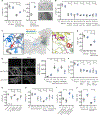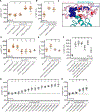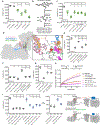Hypoxia and intra-complex genetic suppressors rescue complex I mutants by a shared mechanism
- PMID: 38215760
- PMCID: PMC10919891
- DOI: 10.1016/j.cell.2023.12.010
Hypoxia and intra-complex genetic suppressors rescue complex I mutants by a shared mechanism
Abstract
The electron transport chain (ETC) of mitochondria, bacteria, and archaea couples electron flow to proton pumping and is adapted to diverse oxygen environments. Remarkably, in mice, neurological disease due to ETC complex I dysfunction is rescued by hypoxia through unknown mechanisms. Here, we show that hypoxia rescue and hyperoxia sensitivity of complex I deficiency are evolutionarily conserved to C. elegans and are specific to mutants that compromise the electron-conducting matrix arm. We show that hypoxia rescue does not involve the hypoxia-inducible factor pathway or attenuation of reactive oxygen species. To discover the mechanism, we use C. elegans genetic screens to identify suppressor mutations in the complex I accessory subunit NDUFA6/nuo-3 that phenocopy hypoxia rescue. We show that NDUFA6/nuo-3(G60D) or hypoxia directly restores complex I forward activity, with downstream rescue of ETC flux and, in some cases, complex I levels. Additional screens identify residues within the ubiquinone binding pocket as being required for the rescue by NDUFA6/nuo-3(G60D) or hypoxia. This reveals oxygen-sensitive coupling between an accessory subunit and the quinone binding pocket of complex I that can restore forward activity in the same manner as hypoxia.
Keywords: C. elegans; NADH:ubiquinone oxidoreductase; NDUFA6; NDUFS4; complex I; electron transport chain; hyperoxia; hypoxia; mitochondria; oxygen.
Copyright © 2023 The Author(s). Published by Elsevier Inc. All rights reserved.
Conflict of interest statement
Declaration of interests V.K.M. is listed as an inventor on patents filed by MGH on therapeutic uses of hypoxia. V.K.M. is a paid advisor to 5am Ventures. O.S.S. was a paid consultant for Proteinaceous, Inc. V.K.M. is on the Advisory Board at Cell.
Figures







References
Publication types
MeSH terms
Substances
Grants and funding
LinkOut - more resources
Full Text Sources
Molecular Biology Databases
Research Materials

